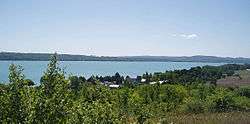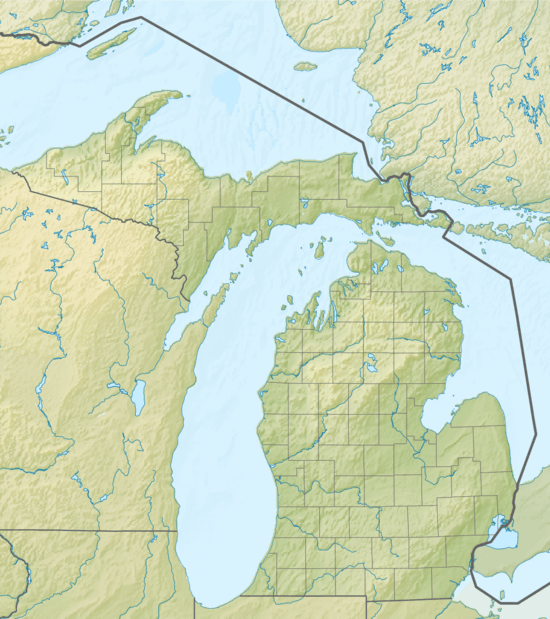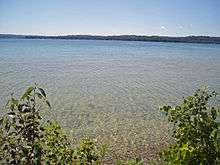Lake Leelanau
Lake Leelanau lies in the Leelanau Peninsula of the U.S. state of Michigan. The entire lake—which includes two bodies of water, usually referred to as North Lake Leelanau and South Lake Leelanau—covers about 8,608 acres (35 km2) and lies within Leelanau County. The lake is also sometimes known as Carp Lake.
| Lake Leelanau | |
|---|---|
 The south half of Lake Leelanau | |
 Lake Leelanau | |
| Location | Leelanau County, Michigan |
| Coordinates | 45°0′N 85°44′W |
| Primary inflows | Cedar Run, Victoria Creek |
| Primary outflows | Leland River |
| Basin countries | United States |
| Max. width | 1.5 miles (2.4 km) |
| Surface area | 2,914 acres (12 km2) North 5,693 acres (23 km2) South |
| Max. depth | 121 ft (37 m) North 62 ft (19 m) South |
| Surface elevation | 587 feet (179 m)[1] |
| Settlements | Leland, Lake Leelanau, Fountain Point, Cedar |

Location
Lake Leelanau connects on the northwest to the Leland River, which runs for one mile (1.6 km) to Lake Michigan. Between North Lake Leelanau and South Lake Leelanau the water narrows for about a mile near the unincorporated community of Lake Leelanau.
A bridge crosses the narrows on M-204. Just south of the bridge is Fountain Point, a historic and scenic landmark as well as a popular summer resort.
On the southern end, South Lake Leelanau ends in a marshy area fed by several small creeks, and the waters access the community of Cedar in Solon Township.
Lake Leelanau runs 21 miles (34 km) through the middle of the Leelanau Peninsula; it is about 1.5 miles (2.4 km) at its widest. The south lake includes 5,693 acres (23 km2), the north lake includes 2,914 acres (12 km2), and the lakes have a total shoreline of about 41.2 miles (66.3 km). The south lake has an average depth of 24 feet (7.3 m), and a maximum depth of 62 feet (19 m); the north lake has an average depth of 40 feet (12 m) and a maximum depth of 121 feet (37 m).[2]
History
Native Americans who first inhabited the area called this land "ke-ski-bi-ag," which means "narrow body of water,".[3]
Henry Rowe Schoolcraft, an Indian agent for the territory, was credited with formally naming the county, and was said to use Leelinau as a character in his writing. See Leelanau County for a more complete discussion of the etymology of the name.
Scholars have established, however, that Leelinau was first used as a pen name by Schoolcraft's wife Jane Johnston Schoolcraft in writings for The Literary Voyager, a family magazine which she and her husband wrote together in the 1820s.[4] Jane Johnston was of Ojibwa and Scots-Irish descent, and wrote in Ojibwe and English. While her writing was not published formally in her lifetime (except as Schoolcraft appropriated it under his own name), Jane Johnston Schoolcraft has been recognized as "the first Native American literary writer, the first known Indian woman writer, the first known Indian poet, the first known poet to write poems in a Native American language, and the first known American Indian to write out traditional Indian stories."[5] In 2008 Jane Johnston Schoolcraft was inducted into the Michigan Women's Hall of Fame.[6]
See also
- List of lakes in Michigan
References
- U.S. Geological Survey Geographic Names Information System: Lake Leelanau
- Compilation of Databases on Michigan Lakes
- Leelanau County website re Lake Leelanau history Archived 2007-12-15 at the Wayback Machine
- Jeremy Mumford, "Mixed-race identity in a nineteenth-century family: the Schoolcrafts of Sault Ste. Marie, 1824-27", Michigan Historical Review, 22 Mar 1999, pp.3-4, accessed 11 Dec 2008
- Robert Dale Parker, Jane Johnston Schoolcraft Archived 2010-06-19 at the Wayback Machine, University of Illinois at Urbana-Champaign, accessed 11 Dec 2008
- Robert Dale Parker, Jane Johnston Schoolcraft Archived 2010-06-19 at the Wayback Machine, University of Illinois at Urbana-Champaign, accessed 11 Dec 2008